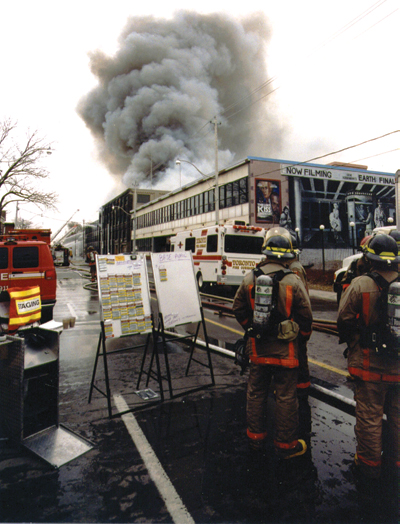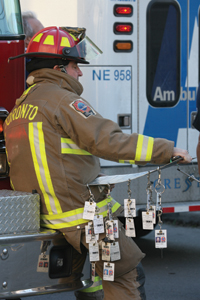
News
Fire ground communication
WEB EXCLUSIVE
Brigade News
Show off your new apparatus in our online version of Brigade News. Fill
out the online form and e-mail us a picture to have your apparatus
featured in our photo gallery.
READ MORE
CURRENT ISSUE
Fire ground communication
Whether you call it communicating with signs and signals, fire ground command, ICS, NIIMS or NIMS, communication and co-ordination will keep us safer at emergency scenes. Peter Sells reports.
February 25, 2009
By Peter Sells
 |
||
| Instituting a system of signs and signals need not be complex, but it does require dedication and discipline.
|
Fighting with a large army under your command is nowise different from fighting with a small one: it is merely a question of instituting signs and signals.
The brilliant and mysterious General Sun Tzu envisioned and practised this concept with large armies made up of conscripted troops, legions assigned by allied warlords, professional mercenaries and captured prisoners (fighting under threat of the sword). The resources he controlled were diverse in terms of experience, motivation, dialect and equipment. Despite the considerable obstacles to mounting an organized large-scale military campaign in the political and economic chaos of China in the Warring States Period (403-221 BC), Sun Tzu reduced the commander’s workload to a manageable level.
How does this system of instituting signs and signals translate into the modern context of multi-agency operations?
- Within each agency’s operational sphere, all members must understand and adhere to their responsibilities under their agency’s system of signs and signals, essentially, and Incident Management System (IMS).
- At the organizational level where the agencies’ command systems overlap, all members of all agencies must understand and adhere to an identical system of signs and signals (unified command).
- The specific system to be used in large-scale multi-agency operations, as well as which agency will take the lead under given circumstances, must be formally agreed to in advance.

|
|
| The result of a system of signs and signals must be the ability to mobilize a group functioning as a single unit toward a common purpose. photo by John Riddell |
Instituting a system of signs and signals need not be complex, but it does require dedication and discipline. The result must be the ability to mobilize a large, diverse and capable group functioning as a single unit toward a common purpose.
The signs and signals we use to communicate are not transmitted by Sun Tzu’s flags and drums. Today we use radios, mobile phones, computer-aided dispatch and all the other wonderful toys that we group together as communications technology. Without communications, the methods we have of organizing work on the emergency scene would be meaningless. In fact, our current practices, despite their basic similarities to ancient military theory, were developed in the era of modern communications.
All fire services operate with a set of local best practices that are inherently similar. Before the 1970s, in North America at least, few fire services had formalized or codified these behaviours into what we now call an IMS. In fact, older communities on the east coast and Great Lakes, whose fire departments were formed in the 18th and 19th centuries, had long traditions of ingrained practice that had become automatic and were passed on to new generations through rote and experience. Nick Brunacini, son of retired Phoenix Fire Chief Alan Brunacini, put it this way in his blog on www.bshifter.com:
“The East Coast Fire Service is older than its West Coast cousin. Big eastern cities developed the operational model they use to conduct structural firefighting operations centuries before the advent of the portable radio and incident command systems. Over the years these departments wrote down what worked best and kept it tacked to the wall in the poop deck. When the wall was completely plastered and three layers deep with operational orders some enterprising member of the company . . . three hole-punched all the pages and organized them into a binder. This became the American Fire Service’s first set of SOPs. Our country’s earliest firefighters celebrated this momentous event by roasting a buffalo and burning down the British Embassy.”
Notwithstanding Nick’s comments, it was primarily the newer western communities, undergoing rapid growth in the 20th century that led the way in getting these things down in black and white. They had to – they had fewer experiences from which to draw. Also, flush with cash in the booming 1950s and ’60s, they had a greater opportunity to integrate many of the post-war technologies as they grew. A notable exception to this east/west divide is FDNY, where a vast amount of firefighting art and science was put to paper and where experiments in fire ground radio had been taking place since 1913.
Despite the vision and diligence of fire departments in striving for continuous improvement, many of the 20th century’s most significant advancements in fire protection practices occurred in reaction to our failures. During the disastrous California wildfire season of 1970, during which 16 lives and 700 structures were lost, it was noted that poor communication and co-ordination among multiple agencies hampered their efforts, no matter how genuinely they wished to co-operate. As a result, within two years the California Department of Forestry and Fire Protection, the Governor’s Office of Emergency Services, the Los Angeles, Ventura and Santa Barbara County Fire Departments and the Los Angeles City Fire Department joined with the U.S. Forest Service in the development of the systems that became known as FIRESCOPE (Fire Resources of Southern California Organized for Potential Emergencies, the quintessential example of a combined acronym and mission statement). One of the first achievements of this group was a formal agreement on common Incident Command System terminology. Although originally developed as a multi-agency system for the wildland environment, ICS was adopted for urban use by the Los Angeles Fire Department in 1978. Therefore, ICS could be thought of as having been developed from the top down, with a system designed for large agencies at upper tiers of government later being adopted for local use.
Alan Brunacini’s first edition of Fire Command was published in 1985. This text introduced most of the North American fire service to the command practices that had been developed locally in Phoenix up to that time. Widely and rapidly adopted, primarily due to the fact that many of its basic practices were already in common use if not formalized as SOPs, many of the book’s principles have grown from the ground up. Many fire services had difficulty, mostly cultural, in adopting ICS because they would wait until they felt an incident was large enough to warrant formalization before establishing a static command post, sectoring the scene and implementing fire ground accountability. The interruption in focus from keeping things moving to getting things organized was not only confusing, it was dangerous. Having a fire ground command mentality – where local incident command begins when the first unit arrives at the scene (typically within minutes) and then grows to suit the size and character of the incident – better suited the minute-by-minute reality of urban fire fighting than the hour-by-hour or day-by-day scope of the wildland environment.
There also are differences in terminology between California’s ICS and Phoenix’s FGC. For example, in ICS a working unit of firefighters organized geographically, on the east side or the fourth floor, would be called a division. If they were organized functionally; for example, for ventilation or fire attack, they would be called a group. Brunacini refers to either as a sector. He also wryly notes that this 30-year debate persists only because the original authors are still alive, but the point is well taken. All language evolves, and technical terminology is no different in that respect. I have always felt that Brunacini’s term “marginal” for the strategic mode during the period of change to defensive from offensive operations would be more intuitively described as “transitional”, but at last report he is still alive and kicking so I will let that one lie.
In the meantime, in 1982 the FIRESCOPE ICS had developed further into the National Inter-agency Incident Management System (NIIMS). In 1993 the IMS consortium began producing model procedure guides that sought to harmonize the best practices of each existing system. Most recently, by presidential directive, the National Incident Management System (NIMS) was issued in 2004. The cynic in me suspects that the sitting president found “nims” easier to pronounce than “ni-ims”, but there’s more to NIMS than a name change. It is an integrated system of protocols that, according to FEMA, will “enable responders at all jurisdictional levels and across all disciplines to work together more effectively and efficiently . . . .One of the most important best practices that has been incorporated into the NIMS is the ICS, a standard, on-scene, all-hazards incident management system already in use by firefighters, hazardous materials teams, rescuers and emergency medical teams.”
NIMS divides management teams, their equipment needs and training requirements into five levels: type 5 is at the city or township level or up to 12 hours’ duration; type 4 is at the county or fire district level for 12 to 36 hours; type 3 involves state agencies or large metro areas for two to seven days; type 2 is at the national level for seven to 14 days; and type 1 is also at the national level for huge incidents of more than two weeks’ duration.
So to put this in a Canadian perspective, consider the following: type 5 is your first-alarm response to Mrs. Smith’s kitchen fire or an MVC on the highway; type 4 is a mutual-aid fire or a multiple-alarm fire in the city (these two types alone represent the majority of emergency responses and the greatest risk to property and the lives of firefighters and taxpayers); type 3 represents the tornadoes in Barrie or Edmonton, the fires at Plastimet or Sunrise Propane, or the August 2003 blackout; type 2 could be compared to the Hagersville tire fire or Mississauga derailment; and type 1 to the 1998 ice storm or the SARS outbreak of 2003.
The National Incident Management System was set up to aid in the response to the largest yet least frequent emergencies. As Alan Brunacini puts it, “99 per cent of our local, all-risk tactical activity is managed by type 4 and type 5 management teams.” After all, assuming the resources are in place, where’s the risk to the responder at a 17-day defensive tire fire? Alan and his sons Nick and John have developed a training system specifically to address the risks associated with incident operations at type 4 and type 5 responses. Their Blue Card Command Training and Certification Program meets the bottom-up needs of the first-due incident commander within the context of the top-down NIMS mandates. Blue Card Command Training was schedule to be available in mid-February through Medteq Solutions (www.medteqsolutions.ca) in a combination online/in-class setting in order to efficiently disseminate this important information. As our industry continues to further define and demand best practice at all levels, tools like Blue Card for the development of command and decision-making expertise are invaluable.
Whether you call it communicating with signs and signals, fire ground command, ICS, NIIMS or NIMS, seamless communication and co-ordination will keep us safer at all emergency scenes – local, regional or national.
Print this page